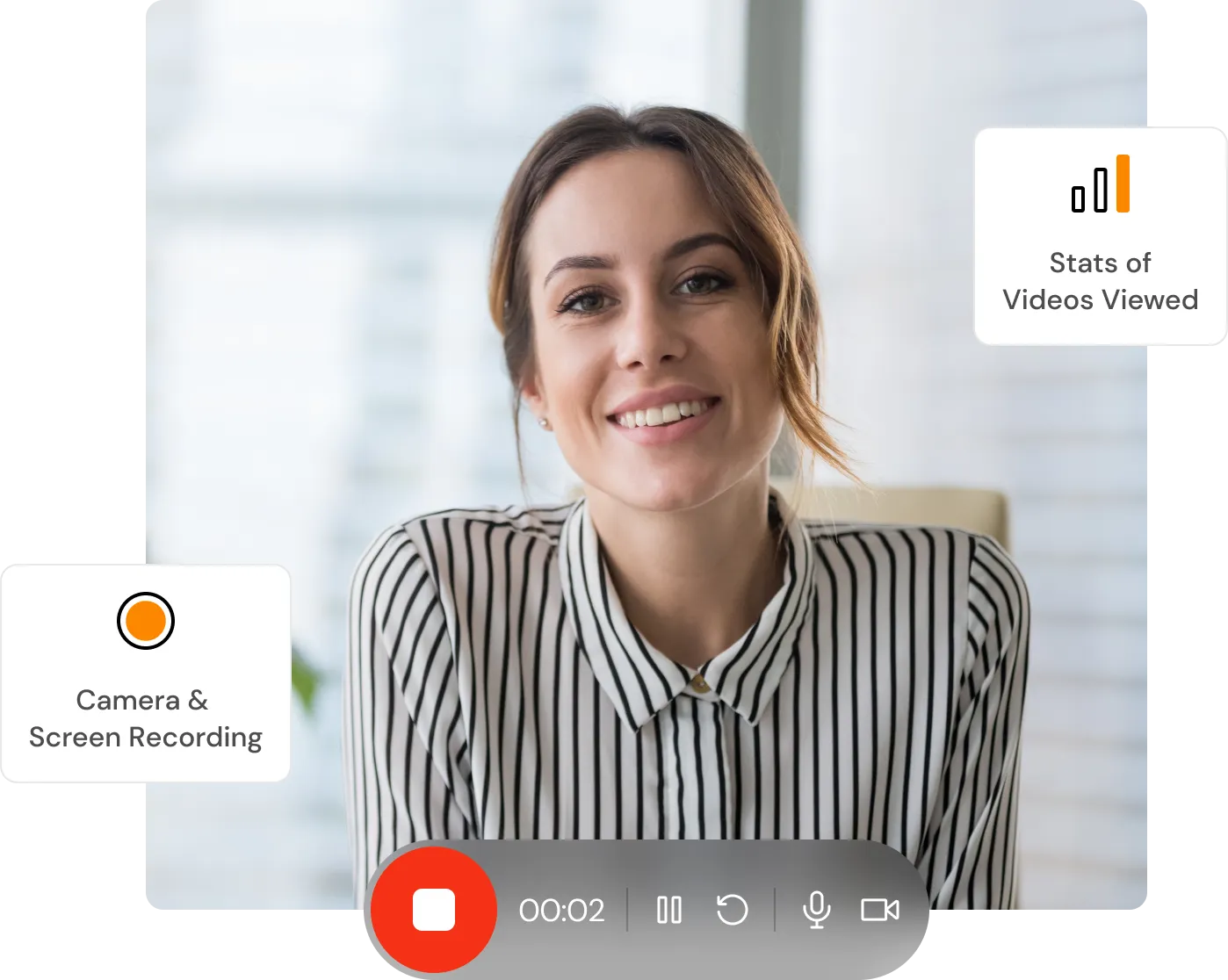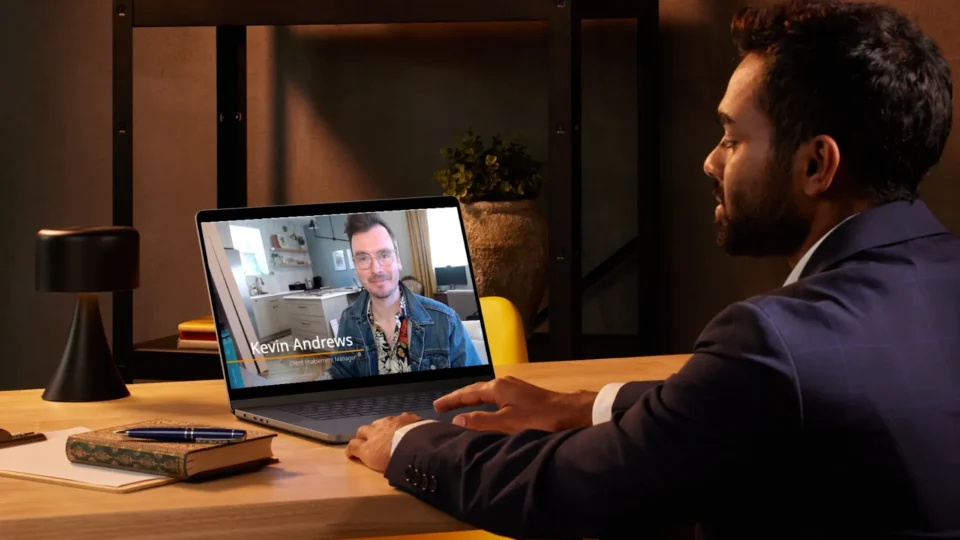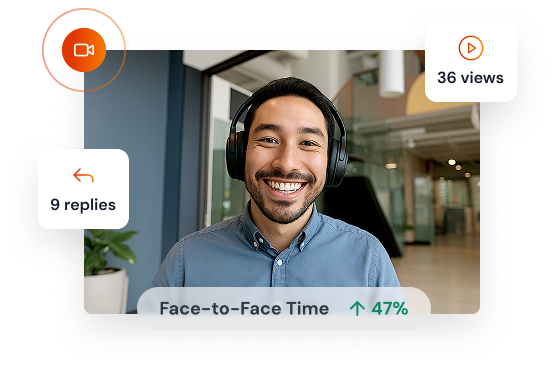Emails, texts, and instant messages are effective forms of business communication. Yet, these channels are missing something important – the warmth of human interaction.
Text-based communication is also getting noisier. As more businesses embrace remote or hybrid work, this problem will only worsen.
The people who suffer in a noisy digital world are those who have something important to say.
Sales people have a harder time attracting prospects.
Marketers can’t engage leads.
Support reps struggle to serve customers.
Employees feel disconnected and unequipped.
We need a better way to communicate – one that leans into our humanity.
This is where video messaging comes in.
What is Video Messaging?
Video messaging refers to the act of recording and sending video messages. Video messages are typically shorter in length – under one minute – and allow one person (or several people) to communicate ideas over a recorded video rather than text.
Video messages are useful in both personal and professional contexts. And they are often far more engaging than the same information conveyed over an email or direct message.
Sending video messages takes some getting used to – especially for people who craft emails and texts carefully. But with a little practice, recording and sharing video messages becomes second nature.
Video messaging is the key to cutting through noise and elevating business communication in an increasingly digital world.
The Benefits of Video Messaging
Video messaging isn’t just about exchanging ideas or information; it’s about building relationships. When video messaging is used effectively, the benefits are obvious.
Multi-dimensional Communication
Video messages convey emotional nuance and empathy better than text-based messages. They bring non-verbal cues back into play – a nod, hand gestures, a concerned frown – and give recipients a better understanding of the sender’s tone and perspective.
In professional contexts, this is crucial. More empathy and understanding leads to better outcomes. People work together more effectively and feel connected to their peers.
More Trust Across Distance
Trust and authenticity are the cornerstones of effective communication. Video messaging offers both, especially in remote interactions.
A sincere “thank you” to a client or heartfelt note from an executive are great use cases for a video message. And the more authentic a video is (i.e., not scripted or rehearsed), the more it enhances the credibility of the sender.
Video messaging also facilitates relationships between remote workers. Videos leave less room for misinterpretation, which minimizes confusion and avoids unnecessary conflict. With fewer negative interactions, remote team members feel more invested in their peers and the organization as a whole.
Fewer Scheduling Issues
Video messaging is also a great solution when dealing with scheduling conflicts. Bringing people together across different time zones is hard, which means it takes longer to get things done.
When combined with a screen recorder, video messages can replace live meetings and presentations altogether. People can use video messages to cover big topics thoughtfully and give others plenty of time to digest the information.
Pre-recorded webinars showcase this well – it’s possible to deliver a compelling and educational experience to people all over the world without having to be on a meeting at the same time.
Higher Productivity
Remote teams typically require more meetings than in-person teams. The quick conversations in the break room or in the hallways don’t happen in remote companies, so those discussions need dedicated meetings.
Video messages and screen recordings can replace these entirely. Employees can watch videos on their own time and respond accordingly.
In fact, our studies show that video messaging can save up to 30% of the time typically spent on traditional communication methods. Workers spend less time typing up long emails or sitting in meetings that could be replaced with short video messages.
Additionally, meeting fatigue is still a common workplace issue. Meeting fatigue stems from prolonged or frequent synchronous meetings. The need to be “camera-ready” and engaged at all times can be mentally exhausting.
Video messages curb this problem and protect employee wellbeing.
Easy Access to Tribal Knowledge
Another benefit of using video messages is that they’re easy to reference. People can pause, skip, and revisit old video messages much like how they would past email chains or texts.
And for many, finding video messages is easier because they are more memorable. Our brains retain videos and images much more than plain text.
Process Integration
Video messaging is simple to integrate into most businesses and workflows. Today’s top video messaging platforms also integrate with widely used enterprise tools, allowing users to send video messages in rhythm with other activities.
Video Messaging Use Cases
On top of the benefits outlined above, video messaging is a powerful tool for specific use cases, especially those that require building relationships and communicating clearly.
Driving Sales
Video messaging improves key metrics and activities for people in sales.
Prospects are more likely to engage with cold outreach that includes personalized video messages. And videos help sales teams set and keep more appointments with warm leads, as well as motivate existing clients to give referrals or make repeat purchases.
Short video messages also enrich post-demo follow-ups and help clarify confusing features. They give potential customers something to reference that not only includes your offer, but also showcases your unique personality, which no other seller can match.
Enterprise-grade video messaging platforms like BombBomb come with in-depth analytics so that sales teams can analyze video-by-video performance. We provide metrics such as play count, percent watched, likes, comments, and CTA clicks so that users know what’s working and what’s not in their sales outreach.
These capabilities are relevant for marketers as well who want to study engagement and conversions for campaigns that include video messages.
Here is an example of a sales rep using a video message to do outbound outreach:
Recruiting Top Talent
Video messaging can play a valuable role in recruiting and employee onboarding. Sending personalized video messages to job candidates makes them feel more excited and connected to the brand during the interview process. Video messages are also a great way to demonstrate empathy and provide feedback to people you don’t hire.
For people you do hire, video messages can streamline the onboarding process and ramp employees up more quickly. HR teams can record explanatory videos for important benefits documentation or processes. And existing team members can share introductory videos with new hires to make them feel welcome before meeting face to face.
Furthermore, prerecorded videos are a great way to document and share knowledge across the organization. Video messages can form the basis of an onboarding or training course for all new hires. And as mentioned previously, people retain information from videos much more than they do text.
Check out this example of a recruiter reaching out to a candidate on LinkedIn:
Improving Customer Service
This not only improves resolution efficiency, but also boosts customer satisfaction and loyalty. For any support topics that come up frequently, reps can build a library of “evergreen” videos – messages that aren’t specific to individuals or circumstances. They can be used over and over while still employing a human touch.
Here’s a video message of one leader explaining how to deal with difficult customer situations:
Elevating Employee Experiences
A similar use case exists on the employee management side. In the same way that customers prefer to receive personalized videos, so do employees.
Video messages are a great way to celebrate milestones and recognize individual performance. They’re also great for providing feedback, sharing project updates, or replacing daily stand-ups.
Compared to plain emails or texts, video messaging fosters a stronger sense of community, leading to higher retention and organizational morale.
Here’s an example of a screen recording with a video message intended for training purposes:
Video Messaging Across Industries
Video messaging is a versatile technology. It’s useful in many industries and helps different types of people in various ways.
Real Estate
Video has been a powerful tool in real estate for many years. Video messaging, in particular, is one of the best ways for realtors to build and maintain relationships with homebuyers.
For example, realtors can send video messages to:
- Introduce themselves to prospective clients
- Follow-up after home visits
- Highlight the community
- Celebrate home buying anniversary dates
Homebuyers want to work with people they like and trust. Realtors who use video messaging are in a much better position to build this positive rapport.
Here’s an example of a real estate team using a video message to commemorate a past purchase:
Mortgage Lending
Mortgage loan officers who use video messaging exist in a category of their own.
Here are a few examples of what types of videos to send:
- Market updates on lending rates
- Explanatory videos on confusing parts of the mortgage process
- Check-in videos with past clients
Mortgage lending is a relationship-driven business. And video messaging is one of the best ways for loan officers to keep in touch with clients and prospects.
Here’s an example of a loan officer using video messaging to give a market update and promote upcoming events:
Automotive Sales
Automotive sales is another area where video messaging makes a huge difference.
Some videos auto sellers can film include:
- Responses to inbound leads about specific cars
- New inventory highlights
- Updates on service work
- Timely check-ins with past car buyers
Here’s an example of a car salesperson using a video message to thank someone for stopping by the dealership:
Homebuilding
Much like in the real estate industry, people want to work with homebuilders they trust. Video messaging gives homebuilders a way to differentiate themselves from the competition and show that they genuinely care about potential buyers.
Some ways that homebuilders use video messaging today include:
- Introducing themselves to new prospects
- Recapping model home walkthroughs and specific features
- Highlighting certain areas in the community
- Providing updates on building progress
Beyond these industries, there are many others where video messaging is beneficial.
Nonprofits could use video messages to engage potential donors. Teachers could provide quick feedback to students. Doctors could check in with patients. The possibilities are endless. Wherever text or email communication is happening today, video would also apply.
Finding a Video Messaging Platform
The right video messaging and screen recording platform should meet the criteria outlined below.
Easy to Use
First and foremost, your video messaging tool has to be easy to use. It should make filming and distributing prerecorded videos simple.
For example, your video messaging platform should be able to embed videos directly into emails, text threads, and instant messages. If you’re sending video messages from within the platform, emails and texts should be deliverable and not end up in spam folders.
And ideally, recipients should see a preview or animated gif that teases the video they are about to watch. Otherwise, you’re asking recipients to open attachments or click unfamiliar links, which they are unlikely to do if they don’t know who you are.
Seamless Integration
Second, your video messaging tool should integrate seamlessly into existing workflows and applications. For example, if your sales team uses Salesforce or Outreach, you should be able to send video messages from directly within the platform. If your support team uses Zendesk, service reps should be able to send videos through chats with end users.
These integrations are important and help promote adoption.
Video Quality
Video quality is obviously important. People are used to seeing most video content today in high definition. While a lot of this depends on the specific devices people use to film videos, it’s worth confirming that your video messaging tool doesn’t compress or reduce video quality significantly when storing or sending.
At the same time, video quality isn’t everything. A high-quality video won’t keep viewers attention if the video content is off. You need both a compelling message and a good-looking video to maximize results.
In-depth Reporting and Insights
Individual users and team leaders need to know how video messaging impacts outcomes. This means having access to data like view counts, clickthrough rates, percent watched, and viewer information down to the individual video whenever possible.
Without this data, it’s hard to identify areas of improvement and implement changes that drive measurable business results.
Available Customer Support
Your video messaging platform should come with robust customer support and comprehensive documentation. As we’ll cover below, video messaging adoption depends largely on people feeling comfortable and capable of using the technology effectively.
Privacy and Security
Privacy and security are paramount in any form of digital communication. When implementing video messaging, it’s essential to choose platforms that take both seriously.
Things like end-to-end encryption, secure data storage, and compliance with privacy laws are essential for maintaining user trust and safeguarding sensitive information.
How to Implement a Video Messaging Platform
Adoption is always a challenge when implementing a new tool or process. Video messaging is no different. People are resistant to change, especially if they are high-performers.
Use the steps below to organize your video messaging rollout:
Focus on Value
Emphasize what value the technology will bring to individuals and the organization at large.
For example, if you’re using video messaging in customer support, explain how the technology will improve CSAT scores and time to resolution (TTR).
If intended for internal communication, calculate how much time you expect your team will save by reducing meetings and scheduling conflicts.
If video messaging will become part of your sales process, give estimates on how much more business you expect people will close.
Provide Dedicated Training
In addition to articulating the value of video messaging, leaders need to provide ample training for their team’s unique use cases. Users need to know exactly how to use video messaging in their roles.
Give Clear Guidelines
We also recommend establishing clear guidelines around recommended video length, appropriate content, and presentation. The more guardrails you provide, the easier it is for people to get started.
Depending on the industry, it might make sense to articulate how people should choose between a video message and a live meeting. For example, quick decisions or brainstorms should happen in a live meeting while information like project updates or feedback are best suited in a video message.
Feedback and Continuous Improvement
After initial adoption, it’s important to get feedback from the people who are using video messaging in your business. Combining this insight with the metrics available in the platform will reveal opportunities to improve.
It’s helpful to focus on a few key performance indicators (KPIs). That way, you can measure how the changes you make as a result of employee feedback affects what matters most to your business.
Video Messaging Best Practices
At BombBomb, we’ve been helping businesses grow with video messaging since 2006. We know how to coach individual users on sending video messages and how to support team leaders when adopting the technology.
For those unfamiliar with how to construct a good video message, here is a list of best practices:
- Organize your thoughts before recording: While you don’t want to be overly rehearsed or scripted, you do want to have an idea of what you want to say before you start recording.
- Follow a framework: Start with an introduction that explains your video’s purpose, followed by the main content and an ending that summarizes the information or presents a call to action.
- Don’t aim for perfection: Treat your videos like voicemails. Video messages are often more compelling when they’re not perfect because viewers are better able to connect with the human-ness of the sender.
- Focus on the value of your message: Don’t worry about how you look or sound – draw your confidence from the usefulness or importance of your message to the sender.
- Be concise, yet clear: Build your video message around one central idea and stay on topic.
- Be intentional about where you film: Film in quiet, well-lit, and organized environments that are free of distractions.
- Match your presentation to the message: Your body language and facial expressions should complement the tone of your message. Simple things like smiling or looking into the camera enhance the feeling of engagement and friendliness.
- Invest in a good microphone and camera: Bad audio and visual can distract from your message and frustrate viewers.
- Consider accessibility: Some people may not be able to listen to your video due to environmental constraints or hearing impairments. Build a habit of always providing a transcript or brief written summary or your video contents.
- Include text context: Include text descriptions with your videos to give viewers context on what they are going to watch and why. This improves open rates, conversions on key actions, and overall deliverability.
If you want to give video messaging a try in your business, sign up for a free trial with BombBomb here.
And if you’re interested in learning more about using BombBomb as a team, book a demo here.




